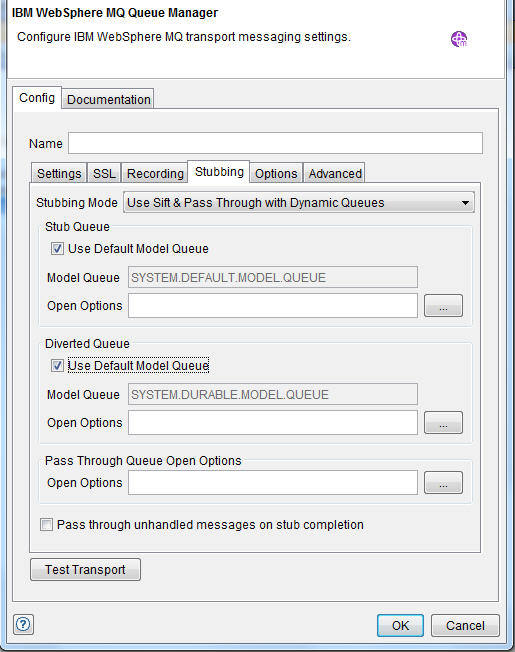By using the Stubbing tab, you can specify the stubbing settings.

| Field/Check box | Description | ||||||||
|---|---|---|---|---|---|---|---|---|---|
Stubbing Mode |
Select one of the available modes for routing messages.
Note: There are no other configuration parameters to specify
for the Direct stub mode in this page.
Note: If you want to specify a default stub mode
for each new WebSphere MQ transport
that is created, click to open the Preferences
dialog box, click Virtualization to open the Virtualization page,
and select the required mode from the Default WebSphere MQ Stubbing
mode list.
Note: If you want to enable sift-and-pass-through
stubbing, you must create a diverted queue rules namelist for any Rational Integration Tester API
exits deployed on the queue manager. For information about this, see Configuring a queue manager to support sift-and-pass-through stubbing.
|
||||||||
Stub Queue, Diverted Queue areas |
Sift-and-pass-through for WebSphere MQ requires
two queues: a stub and a diverted queue. Both of these queues are
created automatically in dynamic mode but needs to be created in fixed
mode.
If Use Sift & Pass Through is
clicked in the Stubbing Mode list, you can:
|
||||||||
Pass through queue |
If any of the Use Sift & Pass Through options are selected as the stubbing mode, the transport is set to MQOO_SET_ALL_CONTEXT option for opening the pass through queue. | ||||||||
Model Queue for Dynamic mode (Stub, Diverted queues) |
In Dynamic mode, the stub queue should be created from a model queue that creates a temporary dynamic queue because only the stub needs to be able to read from this temporary queue, which must be deleted when the connection is closed. The diverted queue should be created as a permanent dynamic queue because multiple connections need to be able to read from, and write to, it. When
a queue manager is created, suitable model queues are created:
Rational Integration Tester uses temporary queues for recording. Select the Use Default Model Queue check box (by default, it is selected) if you want to specify SYSTEM.DEFAULT.MODEL.QUEUE or SYSTEM.DURABLE.MODEL.QUEUE (as applicable) as the object from which to copy attributes. If you want to specify a different model queue, clear the Use Default Model Queue check box and enter a queue name in the Model Queue field. If you are using Rational Integration Tester 8.5.0.1 or later, the prefixes used by Rational Integration Tester when creating WebSphere MQ model queues for the sift-and-pass-through capability have been changed to be more consistent.
|
||||||||
| Suffix for Fixed mode (Stub, Diverted queues) | You must manually create the stub and the divert
queues with appropriate suffix before running the stub. By default,
.STUB and .DIVERT suffix is used by Rational Integration Tester for
identifying these queues, which can be changed, if required. For example: To run a stub using queue Q1, you must manually create Q1.STUB and Q1.DIVERT before you run the stub. |
||||||||
Open Options (Stub, Diverted, Pass Through queues) |
If you are using Rational Integration Tester 8.5.0 or later, you can override default options when you are opening model queues. By default, the Open Options field is blank and the value of 1 (MQOO_INPUT_AS_Q_DEF) is used. Entering a valid numeric value in the field overrides the default. Note: Only
advanced users of Rational Integration Tester who
have a deep understanding of WebSphere MQ should
use the Open Options field. Any value entered
in the Open Options field is not validated
when you click Test Transport or OK.
However, an invalid value causes a warning message to be displayed
when you start a stub.
|
||||||||
Pass through unhandled messages on stub completion |
To pass the queue messages that were not handled by the stub to the "real" queue, select this check box. Clear this check box to discard the queue messages that were not handled by the stub. |